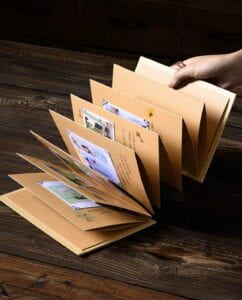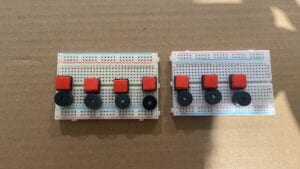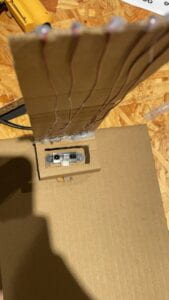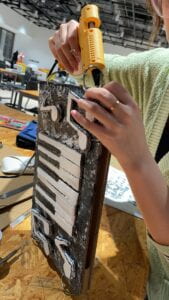II. Conception and Design
A book

As mentioned, we expected the basic form of our project to be a book, because a book:
1. is portable (and foldable).
2. has a cover and multiple pages, so “readers” will have the experience of “opening the book” and “flipping the pages.”
3. usually tells a certain story or with a certain theme, so that “readers” are engaged.
We also considered how to bind pages – there are so many different ways (sewn binding, glued binding, lay-flat binding, wired, saddle-stitched, etc.).
Instruments

Besides, to maximize our user experiences, taking the keyboard as an example, we decided to make each key flexible like a real piano, so the user will feel and see the movement of the key by their finger press. At first, we thought of using touch sensors as our input. However, a touch sensor requires physical contact with skin (so no cardboard or other materials could be inserted in between) and it does not provide physical feedback. Thus we switched to large push buttons. What’s more, a real piano allows multiple keys to make sound at the same time and produces chords and harmony. So we planned to assign a separate buzzer for each key (button).

As for the guitar, a sharp distance sensor was used to sense the distance to the user’s palm. We hesitated between the ultrasonic sensor and this sharp distance sensor, and eventually chose the second. Because we learned that the sharp distance sensor (using light sense) is more accurate and responsive (faster) than the ultrasonic sensor (using sound sense), though the ultrasonic sensor is easier to be coded. Further coding and processing were needed to “translate” the number of distances to different notes (tones).
Materials
Below listed are all the materials we used:
1. Cardboards – We used cardboard for most of our main structures, including the covers, pages, keys, guitar necks, guitar base, and other minor decorations.

2. Iron rings – We bought 10 iron rings from Taobao to bind book pages after we drilled holes along the side of each page (two holes on each side). We did not choose to use other bookbinding ways because this seemed to be the most flexible way – users can easily assemble or separate the book leaves (instruments) as they want.
3. Push buttons – We used 7 push buttons in total, for tones C, D, E, F, G, A, B.
4. Buzzers (then replaced by speakers) – We tried 8 (7 for the keyboard and 1 for the guitar) buzzers at first, but eventually we only used 4 speakers.
5. Sharp distance sensor – for the guitar.
6. Copper wires – We used copper wires as the strings for the guitar (decoration).
7. Paints and brushes – We borrowed red, blue, black, and white paints and brushes from the Equipment Room.
8. Arduinos (3), breadboards (4), wires, tapes, glue guns, scissors, cutters, vises, A4 print paper, etc.